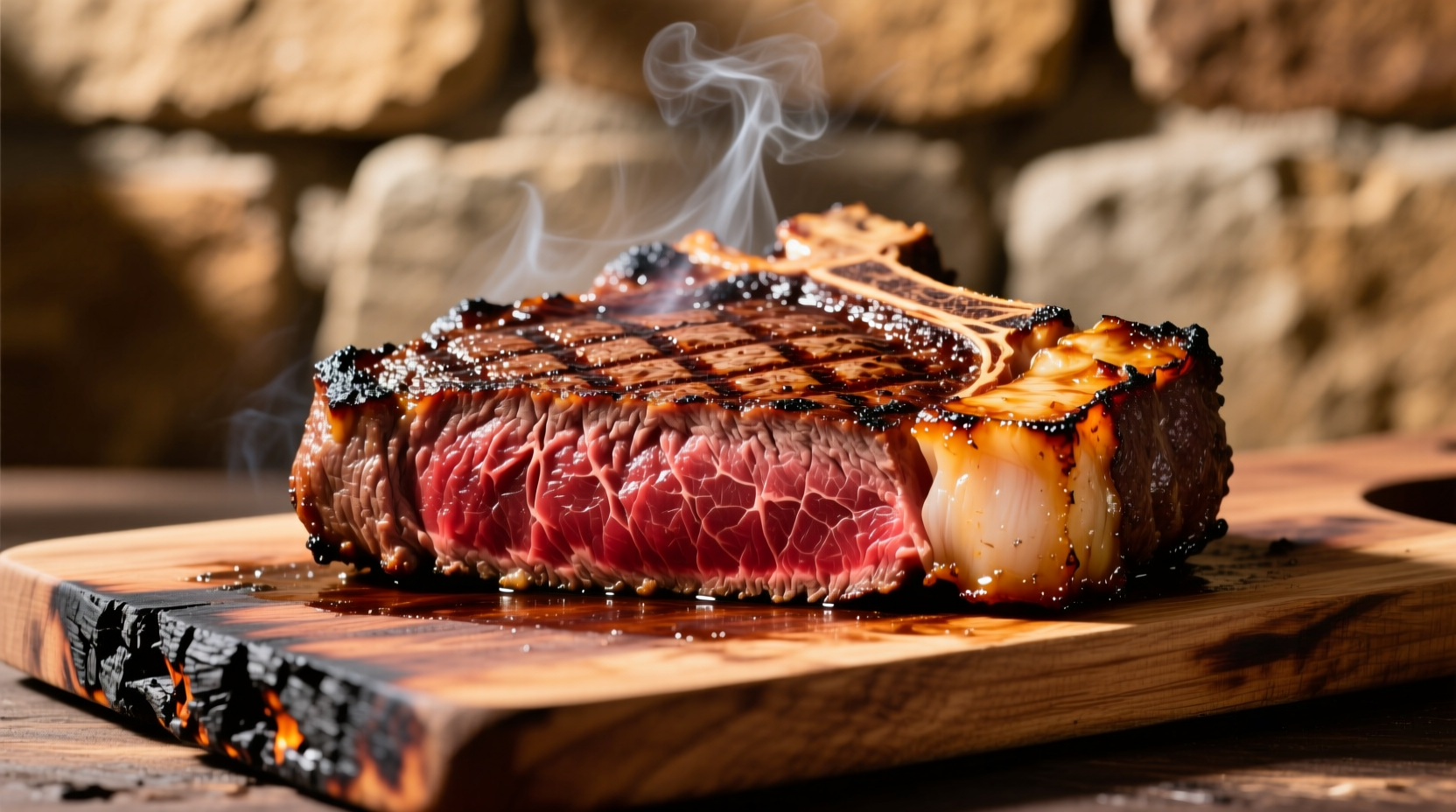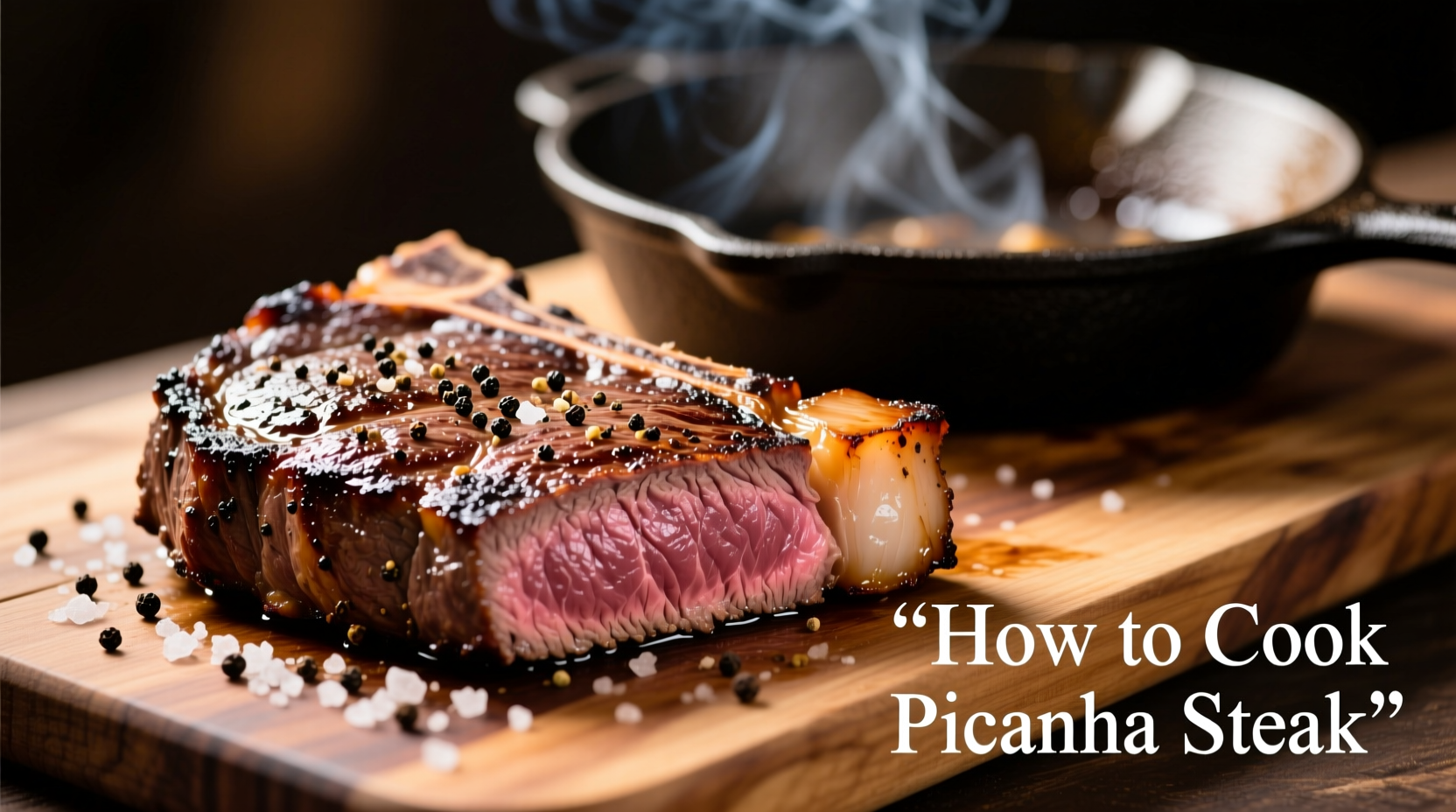Mastering picanha steak—the crown jewel of Brazilian churrascos—starts with understanding this unique cut's characteristics. Unlike traditional steaks, picanha features a thick fat cap running along one side that renders beautifully during cooking, creating an unparalleled flavor profile. When prepared correctly, you'll achieve a crispy, savory exterior with a tender, juicy interior that melts in your mouth. Forget complicated marinades; the secret lies in proper heat management and respecting the cut's natural qualities.
What Makes Picanha Special
Picanha (pronounced pee-kahn-ya), known as "sirloin cap" or "rump cover" in English, comes from the top of the sirloin near the rump. This triangular cut features a distinctive fat cap that's essential to its cooking process. Originating in Brazil where it's the star of churrascarias, picanha has gained global popularity for its rich marbling and beefy flavor without excessive fattiness.
| Characteristic | Picanha | Ribeye | Filet Mignon |
|---|---|---|---|
| Location on Cow | Top sirloin (rump) | Upper rib section | Tenderloin |
| Fat Content | Moderate with distinctive fat cap | High marbling | Low |
| Flavor Profile | Rich, beefy, complex | Buttery, rich | Mild, delicate |
| Cooking Method | Best grilled fat-cap up | Versatile | Precise temperature control |
Selecting and Preparing Your Picanha
When shopping for picanha, look for a cut with a thick, even fat cap (about 1/4 to 1/2 inch thick) and fine marbling throughout the meat. The fat should appear white and firm, not yellowed. Butcher shops and Latin American markets typically carry authentic picanha, though some larger supermarkets now stock it in their specialty meat sections.
Before cooking, trim the fat cap to about 1/4 inch thickness, leaving enough to render during cooking but not so much that it becomes chewy. Score the fat cap in a diamond pattern about 1/8 inch deep—this helps the fat render evenly and prevents curling. Never remove the entire fat cap; it's essential for flavor and moisture.
Bring your picanha to room temperature for 45-60 minutes before cooking. This ensures even cooking throughout the thick cut. Pat the surface completely dry with paper towels—moisture is the enemy of proper searing.
Seasoning for Authentic Flavor
Brazilian tradition favors minimal seasoning to highlight the meat's natural flavors. Generously coat all sides with coarse sea salt or kosher salt (about 1 teaspoon per pound). Some prefer adding freshly cracked black pepper after cooking to prevent burning. Avoid marinades or complex spice rubs that mask the meat's distinctive taste.
For traditional Brazilian churrasco style, use sal grosso (coarse salt) applied during the final minutes of cooking. This technique creates delightful salt crystals that add both flavor and texture. The salt should be applied when the steak is about 10-15 degrees below your target temperature.
Perfect Cooking Methods
Grilling delivers the most authentic results for picanha steak. Set up your grill for two-zone cooking with medium-high heat (375-400°F). Place the steak fat-side down initially for 2-3 minutes to render some fat, then rotate to position the fat cap facing upward for the remainder of cooking. This allows the melting fat to continuously baste the meat.
Maintain consistent heat and avoid flipping frequently—turn only once halfway through cooking. For a 2-3 pound picanha, expect 15-20 minutes total cooking time. Use an instant-read thermometer to monitor internal temperature:
- Medium-rare: 130-135°F (ideal for maximum tenderness)
- Medium: 140-145°F
- Medium-well: 150-155°F (not recommended as it dries out the cut)
For indoor cooking, use a cast-iron skillet over medium-high heat. Start fat-side down, then finish in a 400°F oven if needed to reach proper internal temperature without over-browning the exterior.

Critical Resting and Slicing Technique
Resting is non-negotiable for perfect picanha. Tent loosely with foil and let rest for 10-15 minutes—this allows juices to redistribute throughout the meat. Cutting too soon releases precious juices onto your cutting board.
Slice against the grain in thin, even strips (about 1/4 inch thick). The grain runs parallel to the fat cap, so position your knife perpendicular to this direction. For traditional Brazilian presentation, cut into "almôndegas" (meatballs) by slicing the picanha into thick strips, then cutting each strip into small cubes.
When Technique Matters: Context Boundaries
While picanha is forgiving, certain situations require technique adjustments:
- Thin cuts (under 1.5 inches): Reduce cooking time by 25-30% and monitor temperature closely
- Very thick cuts (over 3 inches): Use reverse sear method—cook low and slow first, then finish with high-heat sear
- Leaner specimens: Increase attention to temperature as less fat means quicker drying
- Smoker cooking: Maintain 225°F until 115°F internal, then finish with high-heat sear
Traditional Serving Suggestions
Serve picanha as the centerpiece of a Brazilian-inspired meal. Classic accompaniments include:
- Farofa (toasted cassava flour)
- Vinagrete (Brazilian salsa with tomatoes, onions, peppers)
- Feijoada (black bean stew)
- Farinha de mandioca (cassava flour)
- Simple grilled vegetables
For sauce, keep it traditional with molho campanha—a simple mixture of finely chopped tomatoes, onions, parsley, olive oil, vinegar, and salt. The vibrant acidity cuts through the richness of the fatty steak perfectly.
Troubleshooting Common Issues
Fat cap isn't crispy: Increase heat during final cooking minutes or finish under broiler for 1-2 minutes. Ensure you scored the fat properly before cooking.
Meat is tough: You likely sliced with the grain rather than against it. Always identify the grain direction (running parallel to the fat cap) and cut perpendicular to it.
Uneven cooking: Your picanha may have varied thickness. Position thinner sections away from direct heat or use the butterfly technique on thicker portions.
Excessive flare-ups: Move steak to cooler part of grill temporarily. Trim excess fat if flare-ups persist, but don't remove the entire fat cap.
Historical Evolution of Picanha Preparation
The cooking technique for picanha has evolved significantly over centuries:
- Pre-19th century: Brazilian cowboys (gaúchos) cooked picanha over open fires on skewers, often with minimal seasoning
- Early 1900s: Introduction of the distinctive diamond-cut fat scoring technique in southern Brazil
- 1950s: Emergence of churrascarias (Brazilian steakhouses) popularized the fat-cap-up cooking method
- 1980s: Development of the two-stage salting technique (initial seasoning plus final coarse salt application)
- Present day: Global popularity has led to adaptations for various cooking equipment while maintaining core techniques
Perfect Picanha: Your Path to Brazilian Steakhouse Quality
Cooking authentic picanha steak successfully hinges on respecting the cut's unique structure and Brazilian culinary traditions. By focusing on proper fat cap management, minimal seasoning, precise temperature control, and correct slicing technique, you'll transform this remarkable cut into a showstopping meal. Remember that the distinctive fat cap isn't waste—it's flavor insurance that self-bastes the meat as it cooks. Whether you're hosting a backyard churrasco or preparing an elegant dinner, mastering picanha cooking connects you to centuries of Brazilian culinary heritage while delivering exceptional results that will impress any steak lover.
What's the ideal internal temperature for picanha steak?
For optimal tenderness and juiciness, cook picanha to 130-135°F for medium-rare. This temperature range allows the fat to render properly while keeping the meat tender. Temperatures above 145°F risk drying out this cut, as picanha has less marbling than ribeye or brisket.
Should I remove the fat cap from picanha before cooking?
Never remove the entire fat cap—it's essential for flavor and moisture. Instead, trim it to about 1/4 inch thickness and score it in a diamond pattern. This allows the fat to render during cooking, continuously basting the meat. The fat cap should face upward during most of the cooking process to facilitate this self-basting effect.
How do I prevent my picanha from curling during cooking?
Curling occurs when the fat cap shrinks faster than the meat. To prevent this, score the fat cap deeply in a diamond pattern (about 1/8 inch deep), which allows the fat to render evenly. Also, start cooking fat-side down for the first 2-3 minutes to render some initial fat before rotating to position the fat cap upward for the remainder of cooking.
Can I cook picanha in the oven if I don't have a grill?
Yes, you can achieve excellent results with a cast-iron skillet and oven. Sear the picanha fat-side down first in a hot skillet, then flip and transfer to a 400°F oven. Use an instant-read thermometer to monitor internal temperature, removing when 5 degrees below your target temperature. The combination of stovetop sear and oven finish mimics grill results effectively.
Why is my cooked picanha tough despite following the recipe?
Tough picanha usually results from slicing with the grain rather than against it. The grain runs parallel to the fat cap, so you must cut perpendicular to this direction. Additionally, insufficient resting time (minimum 10 minutes) causes juices to escape when slicing. Overcooking beyond 145°F can also make this cut dry and tough due to its moderate marbling.











 浙公网安备
33010002000092号
浙公网安备
33010002000092号 浙B2-20120091-4
浙B2-20120091-4